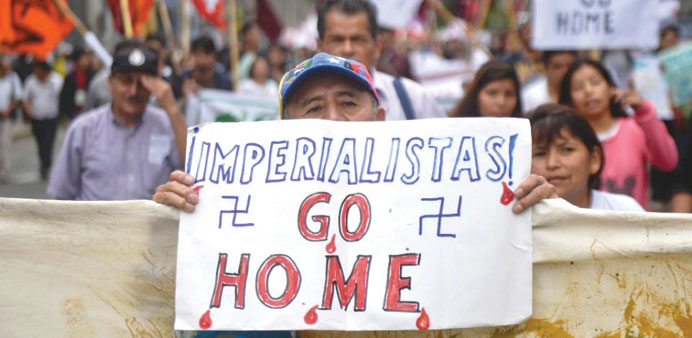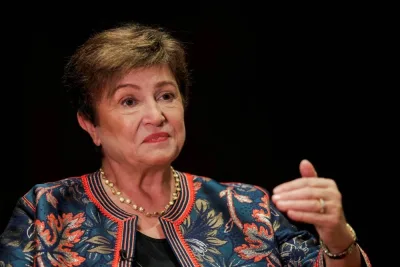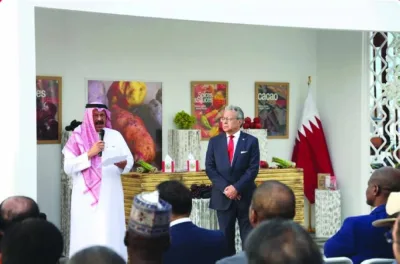AFP/Lima
Activists marched through the Peruvian capital Friday to protest what they called the anti-poor policies of the International Monetary Fund and World Bank, which are holding their annual meetings here.
Around 2,000 demonstrators joined the march, carrying signs with angry slogans and at one point burning the flag of the United States, where the IMF and World Bank are based.
“Imperialists go home,” said one sign decorated with swastikas. “World Bank, universal terror,” said another.
Police in riot gear carrying shields and tear gas bombs accompanied the protesters on the three-hour march, but ultimately no clashes broke out.
When the march reached the meeting venues -- which have been surrounded by a heavy security presence all week -- a small group of protesters was allowed to go inside to hand a petition over to officials.
“Stop cutting payrolls to get out of the crisis,” it said.
The demonstrators, some of whom wore traditional Andean indigenous garb, threatened to call a national strike if the Peruvian government continued to “blindly” implement IMF policy prescriptions.
The march was called by Peru’s largest labour union, the Workers’ General Confederation of Peru (CGTP).
“The economic growth the International Monetary Fund talks about in Peru in recent years hasn’t been felt in the working class. It’s gone to businessmen,” said CGTP leader Domingo Cabrera.
The IMF and World Bank have long had thorny relations with Latin America, where they have faced accusations of forcing governments to cut programmes for the poor in exchange for access to loans.
This is the first time the institutions have held their annual meetings in the region since 1967.
IMF chief Christine Lagarde sought to downplay criticisms Thursday as she kicked off the meetings in a region long resentful of being seen as America’s back yard.
“The world has changed ... The IMF has changed,” she said. “It’s not the old Latin America. It’s not the old IMF either. The relationship is one of cooperation and partnership.”
The world’s top finance officials lavished praise on Peru’s “economic miracle” this week, lauding it for cutting poverty by half during a decade-long bonanza of record-high prices for gold, copper and other metals it mines.
In a gleaming $160mn convention centre built for the meeting of the World Bank and International Monetary Fund, policymakers called Peru a prize pupil of their prescriptions for financial stability.
World Bank president Jim Yong Kim deemed it a “growth star.” IMF chief Christine Lagarde likened Peru’s economic growth recipe to its world-famous cuisine.
Unfortunately, the praise may have come too late.
Plunging prices for minerals, Peru’s economic backbone, have cut annual growth to less than half the 6.3% that made it the envy of Latin America from 2002-2012, a period when per capita income doubled to more than $6,600.
Several mammoth mining projects have been stalled by violent protests and declining mining revenues threaten to force cuts in the social spending.
That means many of the Peruvians lifted out of extreme poverty are at risk of falling back.
“The reality is that The World Bank and International Monetary Fund fiesta is happening when everyone says the party’s over,” said Jose de Echave, an economist and former deputy environment minister. He said the country squandered a golden opportunity during the boom to diversify an economy long dependent on mining for most of its export earnings.
Twenty-three percent of Peruvians are poor by IMF definition. Many of the 40% in the next bracket — the “emerging middle class” earning $4 to $10 a day — are now at risk of joining them.
Enrique Felix, a 50-year-old security guard where the meetings are being held, is one of them. He earns about $340 a month and his soiled shirt and rusted eyeglass frames attest to it.
“We’re a middle class that rents, where no one owns their home and children get lousy educations,” he said as delegates arrived in black limos. “If my kids get sick I don’t know what I’ll do.”
Felix’s wife was 37 when kidney disease took her two years ago.
He has worked for 20 different companies — as waiter, construction worker, messenger and shop clerk. He has a two-hour commute to work on rickety buses and only sees his 12- and 15-year-old children for an hour a day, time he spends cooking for the next day: “Soups generally, and a bit of potatoes.”
Across all of Latin America, the anti-poverty charity Oxfam says 200mn people, or one-third of the population, live in similar conditions.
We’re talking about people with very precarious incomes,” said Oxfam economist Armando Mendoza. They have no savings or access to decent health care. “A family member’s job loss or a serious illness throws them into poverty.”
More than 60% of Peruvians workers are in the informal economy, according to UN figures, spending on health care and education are below regional averages and most government revenues come not from income tax but rather taxes on sales and consumption.
That puts the burden disproportionately on the poor in the region with the world’s most unequal wealth distribution. Latin America’s richest 10% hold 71% of its wealth, Oxfam says in a new report. In Peru, 515 multimillionaires have riches equal to 32% of gross domestic product, it says.
Finance minister Alonso Segura said in an interview that Peru is in good shape to weather the biggest flight of capital from emerging markets in a quarter century. It has reserves of more than $60bn, or about 30% of gross domestic product.
With 2.4% growth forecast this year, the Peruvian economy will still easily outperform Latin America, whose overall output the IMF expects to shrink by 0.3 percent.
The country also gets something of a boost from cocaine, of which it is the world’s top producer, although Segura declined to estimate how much.

Demonstrators protest against the International Monetary Fund annual meetings taking place in Lima.


